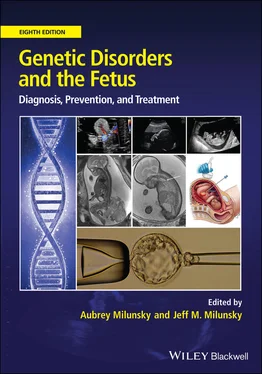Genetic Disorders and the Fetus
Здесь есть возможность читать онлайн «Genetic Disorders and the Fetus» — ознакомительный отрывок электронной книги совершенно бесплатно, а после прочтения отрывка купить полную версию. В некоторых случаях можно слушать аудио, скачать через торрент в формате fb2 и присутствует краткое содержание. Жанр: unrecognised, на английском языке. Описание произведения, (предисловие) а так же отзывы посетителей доступны на портале библиотеки ЛибКат.
- Название:Genetic Disorders and the Fetus
- Автор:
- Жанр:
- Год:неизвестен
- ISBN:нет данных
- Рейтинг книги:4 / 5. Голосов: 1
-
Избранное:Добавить в избранное
- Отзывы:
-
Ваша оценка:
- 80
- 1
- 2
- 3
- 4
- 5
Genetic Disorders and the Fetus: краткое содержание, описание и аннотация
Предлагаем к чтению аннотацию, описание, краткое содержание или предисловие (зависит от того, что написал сам автор книги «Genetic Disorders and the Fetus»). Если вы не нашли необходимую информацию о книге — напишите в комментариях, мы постараемся отыскать её.
Genetic Disorders and the Fetus — читать онлайн ознакомительный отрывок
Ниже представлен текст книги, разбитый по страницам. Система сохранения места последней прочитанной страницы, позволяет с удобством читать онлайн бесплатно книгу «Genetic Disorders and the Fetus», без необходимости каждый раз заново искать на чём Вы остановились. Поставьте закладку, и сможете в любой момент перейти на страницу, на которой закончили чтение.
Интервал:
Закладка:
Library of Congress Cataloging-in-Publication Data
Names: Milunsky, Aubrey, editor. | Milunsky, Jeff M., editor.
Title: Genetic disorders and the fetus : diagnosis, prevention, and
treatment / edited by Aubrey Milunsky, MB BCh, DSc, FRCP, FACMG, DCH
and Jeff M. Milunsky, MD, FACMG.
Description: Eighth edition. | Hoboken, NJ : Wiley-Blackwell, 2021.
Identifiers: LCCN 2021058739 (print) | LCCN 2021058740 (ebook) | ISBN
9781119676935 (hardback) | ISBN 9781119676973 (adobe pdf) | ISBN
9781119676959 (epub)
Subjects: LCSH: Prenatal diagnosis. | Fetus–Diseases–Genetic aspects. |
Fetus–Abnormalities–Genetic aspects.
Classification: LCC RG628 .G46 2021 (print) | LCC RG628 (ebook) | DDC
618.3/2075–dc23
LC record available at https://lccn.loc.gov/2021058739
LC ebook record available at https://lccn.loc.gov/2021058740
Cover Design: Wiley
Cover Image: © (Left column): Rasi Bhadramani/iStock/Getty Images.
(Top row)(left) Roland Axt-Fliedner and Aline Wolter; (center) Liesbeth van Leeuwen,
Malou A. Lugthart, and Eva Pajkrt; (right) Liesbeth van Leeuwen, Malou A. Lugthart, and
Eva Pajkrt. (Middle row)(left) Nadine Girard and Kathia Chaumoitre; (center) Nadine Girard
and Kathia Chaumoitre; (right) Michael A. Belfort and Alireza A. Shamshirsaz.
(Bottom row)(left) Anver Kuliev and Svetlana Rechitsky.
Preface
Certainty and trust are the hallmarks of prenatal diagnosis where doubt and ambiguity are outlaws. At no time was that more apparent than when AM made his first prenatal genetic diagnosis over 50 years ago. “Are you sure?” were that patient's first words, intoned with deep anxiety. Those words underscored the still cogent need for accuracy in prenatal diagnosis, where mostly a single report would be final. That was a time when prenatal diagnosis depended on amniocentesis‐based study, yielding an accuracy rate exceeding 99 percent. Few laboratory tests, then or now, concerned with profoundly important decision‐making equal this enviable accuracy. Variants of uncertain significance had not yet entered the genetic lexicon.
Today, however, with the newer, beguiling, noninvasive technology, amniocentesis and chorionic villus sampling (CVS) use has declined dramatically. On the altars of convenience and expediency, women are choosing or simply encouraged to have noninvasive prenatal testing, often blissfully unaware that about half of all chromosomal abnormalities detectable through amniocentesis or CVS and authoritatively discussed, would be missed. There is room for concern given the current consensus that all women should be offered either of these two procedures.
Similarly, all women with risks of having offspring with a monogenic disorder and a known pathogenic variant should be informed about and offered the option of preimplantation genetic testing (PGT). The extensive and long‐established experience of the authors with PGT enshrine this recommendation. Expanded carrier screening should make this a more frequently addressed option. Couples should, however, be carefully counseled about the limitations of such screening. All the facts, figures, guidelines, and recommendations have been updated in this edition, and will assist the expanded healthcare team in providing optimal care to all patients.
Coupled with remarkable advances in technology, prenatal diagnosis has undergone a revolution. Thus far, and continually increasing, more than 4,331 culprit genes and 6,739 associated phenotypes for an extensive array of genetic disorders have been identified. Consequently, since physicians in all medical specialties encounter genetic disorders for which a molecular diagnosis is available, awareness of the options for prenatal diagnosis or PGT has become especially important.
Pari passu with these technical advances has come the opportunity to avoid and prevent the occurrence of many lethal and seriously disabling genetic diseases. This progress means that physicians in all specialties incur responsibility (and inevitable liability) to acquire new knowledge of genetic disorders and offer appropriate tests or refer patients for evaluation and genetic counseling.
More than 60 million people worldwide are estimated to have DNA studies in the next 5 years. Expanded carrier testing, maternal cell‐free plasma DNA testing, whole‐exome sequencing, next‐generation sequencing, single‐cell molecular diagnosis, and advanced fetal imaging, all fully presented in this volume, now complement the well‐established procedure for prenatal diagnosis and PGT. Whole‐genome analysis for prenatal diagnosis (even if advisable) simply awaits further technical advances.
Chromosomal microarrays and whole‐exome sequencing have propelled an even greater prenatal diagnostic reach, especially in the face of fetal structural, including skeletal, abnormalities, given the advances in ultrasound and magnetic resonance imaging, so expertly covered in this volume by authors from three European countries.
The fetal anomaly scan has to an important extent superseded amniotic fluid α‐fetoprotein for the diagnosis of neural tube defects. Nevertheless, the significant worldwide prevalence of neural tube defects makes maternal serum α‐fetoprotein screening a continuing vital test, critically evaluated here by a pioneer. The diagnosis of neural tube defects and their consequences, as well as the frequently failed efforts at prevention, are thoroughly detailed.
Knowledge of the common sex chromosome aneuploidies and some of the rarer variants continues to expand. Up‐to‐date summaries of all these disorders are presented with specific recommendations for genetic counseling. Molecular prenatal diagnosis has now become routine and the multiple technologies utilized, with their benefits and limitations along with clinically based caveats and considerations, are presented in a significantly updated chapter.
The advent of next‐generation sequencing has, by targeting panels or whole‐exome approaches, resulted in more opportunities for avoidance and prevention through prenatal diagnosis. These widely available technologies not only address previously diagnosed childhood‐onset disorders, but also those of adult onset, including cardiomyopathies, malignancies, and neurologic disorders.
Progress and refinement in the diagnosis and management of a wide range of metabolic disorders are fully and authoritatively updated, and equally complemented by the detailed in‐depth advances in molecular diagnostics that include the hemoglobinopathies, fragile X syndrome, cystic fibrosis, disorders of folate metabolism, and the immunodeficiency diseases.
Pregnancy termination is a sad but fortunately uncommon consideration following prenatal diagnostic studies. The techniques and complications are fully discussed and complemented by insightful senior experience with the management of grief after pregnancy and perinatal loss. Discussion about the care and management of mothers with genetic disorders that affect fetal health and those who transmit infection to the fetus is sharply focused on diagnosis, prevention, avoidance, and treatment. Fetal health is doubly important given the known fetal origins of adult disease that go far beyond hypertension, obesity, and diabetes, to include the epigenetic phenomena induced by the maternal pregnancy environment. A thorough exposition on the importance of placental development, structure, function, genetics, and pathology on fetal growth and development is expertly presented in this edition. Steadily, but surely, fetal gene therapy via hematopoietic stem cell transplantation is taking root, while a remarkable chapter on fetal surgery by a leader in the field points to new brave surgical remedies.
While all authors acknowledge continuing progress in molecular genetics, inconclusive results due to variants of uncertain significance are not infrequent. Laboratory conclusions can be further compounded by a host of issues that potentially befuddle interpretation. Commonly encountered issues include delineation of normal variation or polymorphisms, difficulty determining the pathogenicity of variants, depth of sequencing coverage, regions of high GC content, mosaicism, DNA contamination, digenic inheritance, locus heterogeneity, and false‐positive and false‐negative results. The concurrence of an incidental (secondary) finding on fetal DNA analysis will predictably arouse great parental anxiety.
Читать дальшеИнтервал:
Закладка:
Похожие книги на «Genetic Disorders and the Fetus»
Представляем Вашему вниманию похожие книги на «Genetic Disorders and the Fetus» списком для выбора. Мы отобрали схожую по названию и смыслу литературу в надежде предоставить читателям больше вариантов отыскать новые, интересные, ещё непрочитанные произведения.
Обсуждение, отзывы о книге «Genetic Disorders and the Fetus» и просто собственные мнения читателей. Оставьте ваши комментарии, напишите, что Вы думаете о произведении, его смысле или главных героях. Укажите что конкретно понравилось, а что нет, и почему Вы так считаете.












